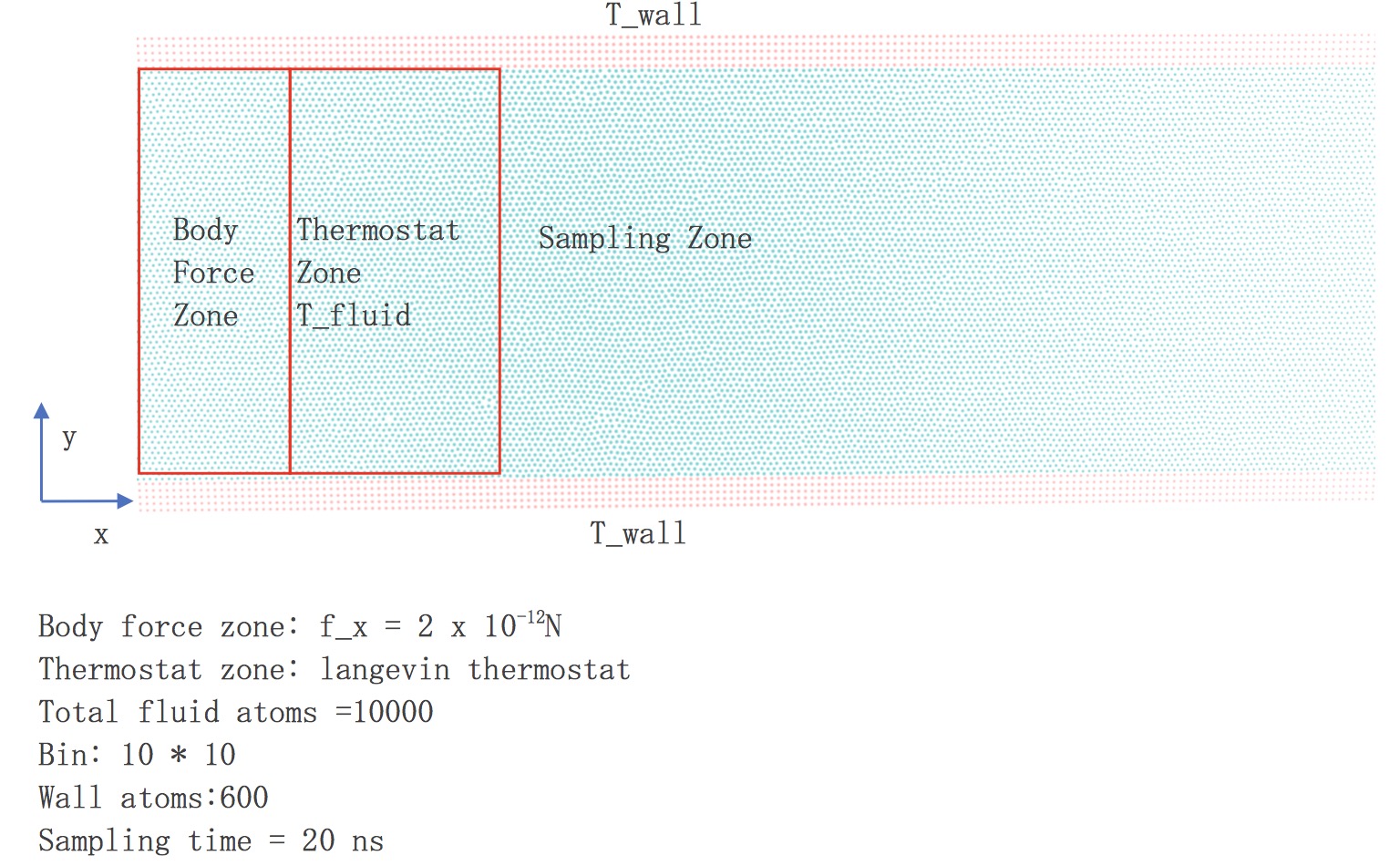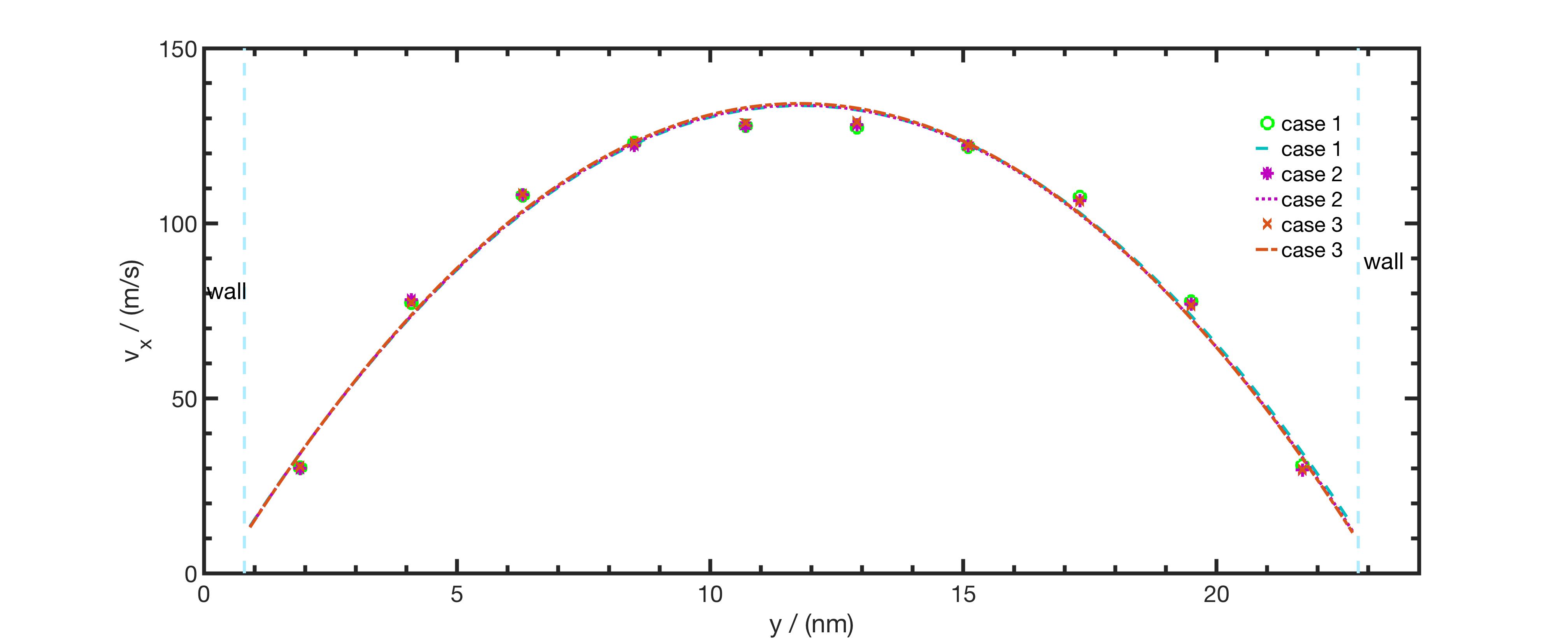Hi all,
I am simulating convective heat transfer in a 2D nanochanel using lammps. These pink points are 600 solid wall atoms and the light green points are 10000 fluid atoms. All solid atoms are constrained to their initial positions using fix spring/self command. p and f style boundary condition is respectively applied in the x and y direction. The fluid zone is divided as three components, body force zone, thermostat zone and sampling zone. For the whole simulation process, 10 fs is treated as the tilmestep and fix nve is used to update all fluid and solid atoms’ positions and velocities.

And the simulation steps is shown as follows
- Control the temperature for wall equal to the temperature for the fluid atoms, namely T_wall = T_fluid. This process last for 2 ns.
- The following 3 ns is used to add body force to fluid atoms in the body force zone and control all fluid atoms’ temperature to equal to T_fluid (now, T_fluid is not equal to T_wall).
- Another 10 ns is applied to only control the temperature for the liquid atoms in the ‘thermostat zone’. Meanwhile, fluid atoms in the body force zone are also added the body force mentioned in the step (2).
- In the last 20 ns, data sampling is conducted for the ‘sampling zone’ and the velocity in x direction. All fluid zones are divided as 10*10 bins and there are ~100 fluid atoms in every bin. Commands I used are
compute 2ps_com_20_1 g_flow chunk/atom bin/2d x 2.8 7.72 y 0.8 2.2 bound x 2.8 80.0 bound y 0.8 22.8 units box # g_flow is a static group for all fluid atoms.
compute 10nps_com_0 g_dynamic_o temp/profile 1 0 0 y 10 #g_dynamic_o is a dynamic group for liquid atoms in the sampling zone.
compute_modify 10nps_com_0 dynamic/dof yes
fix 10nps_re_0 all ave/chunk 2 1000000 3600000 2ps_com_20_1 vx vy density/number temp bias 10nps_com_0 file nn_10_1.out format %20.16g
For the same model, I test three cases.
Case 1: T_wall=120 K T_fluid=200K
Case 2: T_wall=200 K T_fluid=200K
Case 3: T_wall=280 K T_fluid=200K
The resultant velocity in x direction and temperature along y direction are


So my questions is why the temperature profile seems not reasonable. Maybe because
(1) I misuse the fix nve to update fluid atoms’ velocities and positions as reported in Lammps documentation ‘This fix ave creates a system trajectory consistent with the microcanonical ensemble.’ (the link is http://lammps.sandia.gov/doc/fix_nve.html). For the sampling zone in my model, however, does not accord with the microcanonical ensemble. If this is the reason for the wrong temperature profile, would you tell me which time integration command I can use for my model ?
(2) For all three cases, there is a large amount viscosity heat occurring at the vicinity of solid wall. However, convective heat transfer between solid wall atoms and fluid atoms is not very obviously. As I used a large body force on fluid atoms in the body force region (the velocity of centre of mass for fluid atoms in the sampling zone is around 100 m/s) and the number for the solid wall atoms is not larger enough.
(3) or some reasons I do not known.
My inputfile for test case 1 is also attached in this email.
I will be grateful for any reviews. Thank you again.
Qiangqiang Sun
in2D.pdf (27.2 KB)